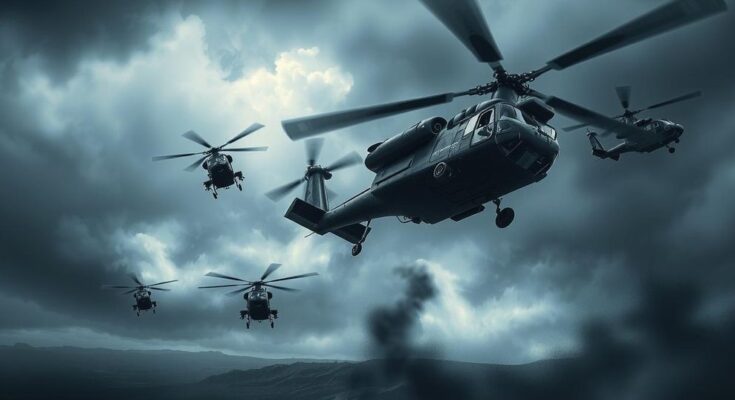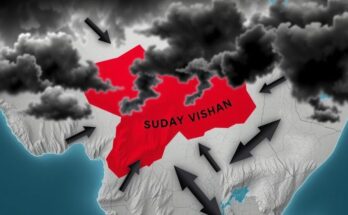This article examines the events surrounding the 1993 Battle of Mogadishu, when U.S. forces lost 18 soldiers and two Black Hawk helicopters amidst a humanitarian intervention in Somalia. It details the U.N. efforts, the challenges faced by peacekeepers, and highlights the long-term implications for U.S. foreign policy and military strategy. Despite international support, Somalia remains entrenched in conflict, continuing to grapple with severe food insecurity.
For years, Somalia has faced ongoing challenges with food insecurity, echoing the dire situation observed during the 1993 Battle of Mogadishu. In this incident, the United States, operating under United Nations directives, tragically lost two Black Hawk helicopters and 18 soldiers while attempting to address famine in the war-torn country.
In 1992, the United Nations initiated the United Nations Operation in Somalia (UNOSOM) to combat civil unrest and hunger in Somalia. Simultaneously, ‘Operation Provide Relief’ aimed to deliver food assistance, but ongoing hostilities among warlords complicated these efforts, hindering aid distribution to those in need.
In response to the deteriorating conditions, the United States under President George H.W. Bush launched Operation Restore Hope in December 1992, deploying troops to assist with humanitarian efforts. This action led to the establishment of the United Task Force (UNITAF), which, empowered under Chapter VII of the U.N. Charter, aimed to maintain peace and facilitate aid delivery.
Despite efforts from UNITAF, the situation remained perilous. The Somali National Alliance (SNA), led by Mohammad Farah Aidid, vehemently opposed UNOSOM II’s peacekeeping initiatives. Tasked with restoring democracy, UNOSOM II encountered significant resistance, complicating efforts to provide humanitarian aid. The UN peacekeepers, numbering 22,000, faced considerable challenges, as they were mandated to cover the entire country instead of the smaller area previously managed by UNITAF.
In June 1993, a violent ambush on Pakistani troops from UNOSOM II during an operation targeting Radio Mogadishu resulted in considerable casualties and heightened tensions. This emboldened the SNA and incited further conflict between the factions, as UNOSOM II began focusing on hunting down General Aidid, leading to a bloody confrontation that would culminate in the infamous Battle of Mogadishu.
Task Force Ranger was deployed with the objective of capturing General Aidid, culminating in an operation known as ‘Gothic Serpent.’ On October 3, 1993, U.S. forces executed a raid in Mogadishu, aiming to apprehend Aidid. They successfully secured a location and captured numerous SNA personnel but did not capture Aidid himself.
The U.S. forces encountered fierce resistance from the SNA, resulting in the destruction of two Black Hawk helicopters. While some crew members survived the crashes, the efforts to rescue them were met with heavy gunfire. At one crash site, intense fighting occurred, leading to both U.S. and Somali casualties.
Despite the attempt to capture Aidid, the operation was largely viewed as a failure, as it resulted in the loss of 18 U.S. soldiers and severe public backlash in America. President Bill Clinton subsequently announced the withdrawal of U.S. forces from combat in the area by March 1994.
The Battle of Mogadishu marked the bloodiest day for U.S. troops since the Vietnam War and led to a reevaluation of American foreign policy regarding military intervention and peacekeeping. The persistent aftermath of this incident left a significant impact on U.S. military strategy and humanitarian efforts abroad.
Years later, Mark Bowden’s publication “Black Hawk Down: A Story of Modern War” and the subsequent film adaptation revived interest in the battle. However, despite the passage of time, Somalia continues to grapple with violence and famine, with current estimates indicating that millions of children face acute malnutrition due to ongoing drought and insecurity, as reported by the World Food Program.
The Battle of Mogadishu remains a pivotal event in U.S. military history, underscoring the complexities of humanitarian intervention in conflict zones. The incident not only resulted in significant U.S. casualties but also triggered a strategic reassessment of American involvement in international peacekeeping efforts. Even after three decades, Somalia’s struggle with violence and famine endures, illustrating the ongoing challenges faced by the international community in rendering effective support to communities in crisis.
Original Source: www.eurasiantimes.com




